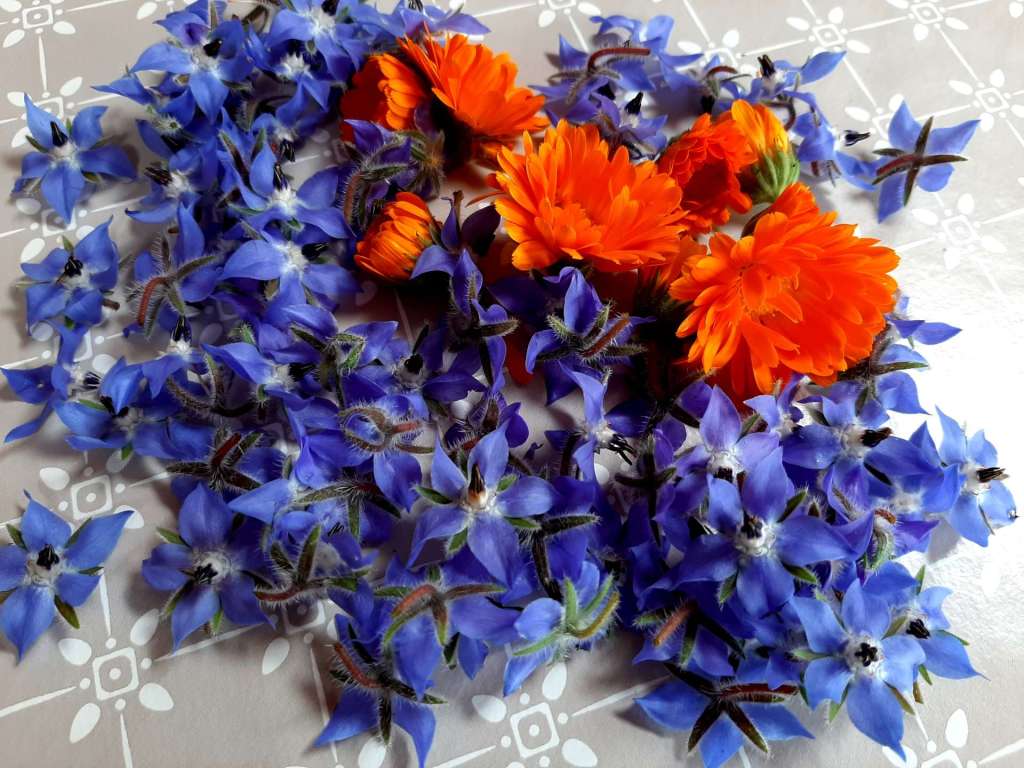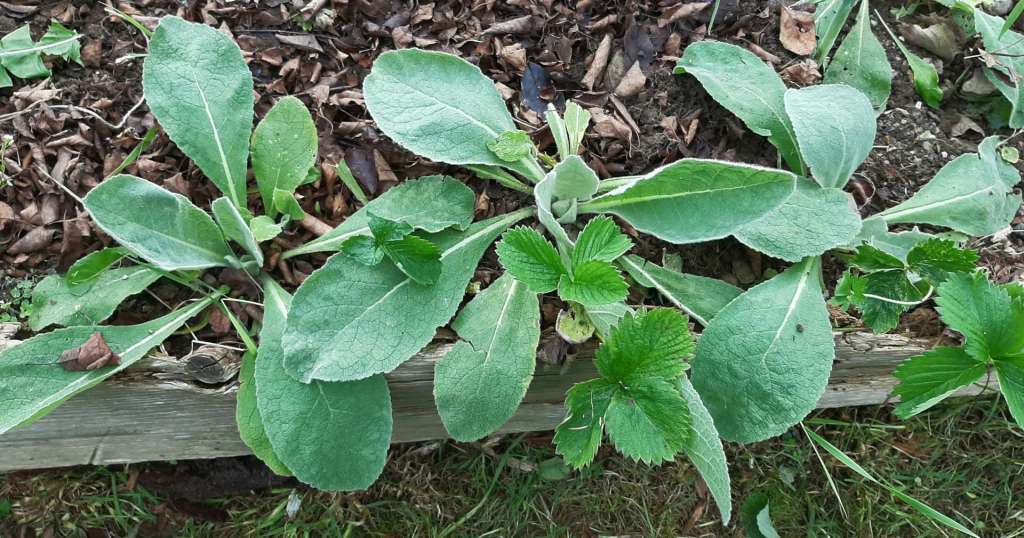Just lately it’s all been about herbs, harvesting them from the garden, drying them, putting them in oil, making powder and so fort. It has been a busy but rewarding time. I’ve learnt a lot more about Dandelion plants and this means that the Dandelion is now been promoted to a primary plant in our garden. Luckily we have a lot of them as I’ve always been reluctant to pull them up from among the other vegetables. Now they have gained a firm status of valuable nutritional source. So far I have dried roots and leaves. The roots are for tea and the leaves are for either a soak in water overnight making a cool drink, or to be grinded into powder to add a touch to soups. I am looking forward to spring when I will use some of the flowers when baking biscuits, only some though as they are earmarked mainly as food for the bees. Nettles are another good source of minerals and they have been growing so well this past summer in our garden. I’ve harvested many and again grinded some into powder for the soups and will use the leaves for a green drink.


Powder made from organic orange peel 
Dandelion root 
Dandelion roots ready to dry


Variety of leaves drying 
Flat leaved parsley 
Rosalee’s book 

Borage and Calendula flowers drying 
Nettle leaves drying
Just recently I had bought the long desired book by Rosalee De La Foret: ‘Alchemy of Herbs’, and I am finding it a brilliant work. So much information, and beautiful photography too. As well as this book I have once again signed on to Herb mentor from Learning Herbs, it’s an amazing informative website and course, a hands on type of learning which is great fun as well as being very interesting. (It’s online; https://learningherbs.com/herbmentor/)

This one is for cleaning 
For making an ointment during winter


Young Mullein plants, just appeared 
And a good harvest of Evening Primrose

All these herbs are humble plants, many of them are even considered to be weeds by some people. I’m so very grateful that they come growing in my garden. Some, like the Yarrow, plantain and violets grow in the boreen close to where we live. On my walks I always keep an eye out for useful wild plants in case I should ever need them, then I know where to find them.
We may be very thankful for the wealth of wild plants and herbs in our gardens.

Looks like you’ve been very busy. 🙂 Herbs are good to have close to hand in the garden. I read recently that they are an excellent source of trace minerals that have been depleted from commercial farms.
LikeLiked by 2 people
I read that too Eliza and so it makes sense to use them as well as being an absorbing activity.
LikeLike
I’m inspired by what you’ve been doing, Agnes. What have you been doing with the evening primrose? Eg drying the flowers? As there are no flowers on violets at the moment, did you collect the flowers earlier in the year or are you now using the leaves?
I now have a dehydrator and do mean to start making ‘coffee’ from dandelion roots. Maybe after they have flowered last spring.
LikeLiked by 2 people
Hi Helen, yes autumn is the best time to dig up some dandelion roots it seems. I intend to put evening primrose flowers on oil but have not got around that, that will be a priority when they flower again next summer. And I have to source a more generous patch of wild violets in order to pick them, or I might sow some in the garden. Those two plants are on my watch list for the moment. I was delighted to read that what I am doing inspires you – and in turn that encourages me too. Cheers.
LikeLike
Wild violets invited themselves into my garden, so it would be interesting to know what I could do with them apart from ear the leaves. Any suggestions?
LikeLiked by 1 person
That’s nice Helen. So far the only thing I came across in use of march violets would be to use the flowers for cake decoration.
LikeLike
They are pretty and they taste nice, too. There are sweets in the U.K. called violets which must once have been flavoured with the flowers. Maybe next year, I do a bit of dabbling in that direction, more for the fun of it than anything.
LikeLiked by 1 person
Yes it’s a very relaxing hobby 🙂
LikeLike
😊
LikeLike
What do you dry in your dehydrator Helen?
LikeLike
So far, I’ve dried: strawberries, rhubarb, apples, onions, carrots, leeks, potato, Jerusalem artichokes, herbs. If it were just the latter, I wouldn’t need a dehydrator but I was getting so many strawberries and getting tired of making endless rounds of jam. I also realised that in a good year, we could be overwhelmed by apples and my daughter loves apple rings.
So, the apples and strawberries were the motivation for buying the dehydrator but I soon started experimenting. Sometimes, we are overwhelmed with certain vegetables from the farm share we get, so I have been drying those we can’t get through fresh. It can then be used as a soup mix when I’m feeling too tired to do much preparation. Besides, it means that we have food on standby in case of needing to self-isolate, though I had no notion that we would be put in this position when I bought the machine!
LikeLiked by 1 person
Sound real good Helen and using a dehydrator is a very sensible idea. Interesting to hear all the stuff that you are drying for future use. More versatile than jam all right. By the way I was reading up a little more on violets and it seems we can use the young leave too as an addition to a salad. I have not tried it yet though.
LikeLike
Thanks for this information about violet leaves, Agnes. Good to know. Have a good evening and hopefully see some more of your writing soon.
LikeLike
An impressive collection. I hadn’t known about dandelion roots
LikeLiked by 3 people
Thanks Derrick, dandelion coffee is rather nice if made creamy. I never realised that you summer the roots for something like 20 minutes. It sure is a learning curve.
LikeLiked by 1 person
What beautiful post – I love how the herbs look above your door and can only imagine how the wonderful scent must fill your home x
LikeLiked by 2 people
Thank you, yes I too enjoy a rustic looking home. I have always enjoyed plants around me either alive or drying to be used.
LikeLike
Oh, I love looking at the photos and reading about your herb preparations, thank you!
LikeLiked by 1 person
Thank you Emma, so glad you enjoy.
LikeLike
You have been very busy:)
LikeLiked by 1 person
🙂 yes I have. Thank you.
LikeLike
Ah, So special to preserve these precious gifts from your yard. I love seeing what you are doing – it inspires me!
LikeLiked by 1 person
Thank you Jodie, they are great gifts and very welcome ♡
LikeLiked by 1 person
Wonderfull !! Kruiden zijn gezond maar ik moet er altijd veel scheetjes van laten .. 😀
LikeLiked by 1 person
Sorry to hear that David, any of the herbs in particular 🙂
LikeLike
An uplifting post – always good to see herbs in action. I’ve let that side of things slip recently but youhave inspired me to get going and start foraging again.
LikeLiked by 1 person
I am delighted, yes it is so rewarding to look for and find wild foods and herbs. Enjoy!
LikeLiked by 1 person
Netle soup, nettle tea and, because of the ground elder in the garden, something using ground elder. I know you can use it, but I always used to leave it too late in the season before I remembered.
LikeLiked by 1 person
Great you have ground elder. We don’t actually have ground elder here I think, at least I have never seen or identified it here. But plenty of nettles, cleavers and dandelions.
LikeLiked by 1 person
It’s probably better not to have it, in gardening terms. The Romans brought it over, it seems. Quite looking forward to it now I’ve done the reading.
LikeLiked by 1 person
Yes you might have a point.
LikeLiked by 1 person
Wonderful. I loved the photo of the herbs hanging 🙂 I too like to make powders of some of the herbs that grow here. This plant which we call Nelanelli is growing wild in our garden. I have added certain spices and made a powder with the leaves. We use as chutney powder and also in certain dishes. Thank you.
KeelaNelli | Phyllanthus Niruri | Regenerative Nutrition
https://www.regenerativenutrition.com/keela-nelli-phyllanthus-amarus…
LikeLike